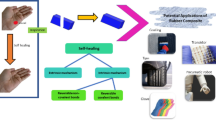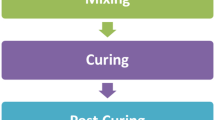Abstract
In this work, a novel self-healing natural rubber was developed, and the concepts of mixing both covalent and reversible ionic crosslinks bonds were proposed. The developed materials have the capability of repairing themselves and recovering functionality when they are damaged without the need for detection. Evidence that covalent and reversible ionic crosslinks bonds had occurred was determined by the equilibrium swelling test. The tensile properties of the cured rubbers before and after the healing process were measured using a universal tensile tester to obtain healing efficiency of the materials. The results revealed that the developed self-healing natural rubber was able to recover 60% of its initial mechanical properties in a minute and almost 100% in 10 min at room temperature without the aid of any external resources. Scanning electron microscopy (SEM) showed that the fracture area recuperated with a scar mark after the healing process. Some of the potential products that could benefit from the advantages of these materials include tires, industrial rubber good, cable, hoses, belting, bearing, mounting and foot-wares.








Similar content being viewed by others
References
Bekas DG et al (2016) Self-healing materials: a review of advances in materials, evaluation, characterization and monitoring techniques. Compos B Eng 87(Supplement C):92–119
Binder WH (2013) Self-healing polymers: from principles to applications. Wiley, Hoboken
Blaiszik BJ et al (2010) Self-healing polymers and composites. Annu Rev Mater Res 40:179–211
Peponi L et al (2016) Smart materials: polymers and nanocomposites. Modification of polymer properties. William Andrew, Norwich, p 131
Zhu DY, Rong MZ, Zhang MQ (2015) Self-healing polymeric materials based on microencapsulated healing agents: from design to preparation. Prog Polym Sci 49–50(Supplement C):175–220
Syrett JA, Becer CR, Haddleton DM (2010) Self-healing and self-mendable polymers. Polym Chem 1(7):978–987
Wu DY, Meure S, Solomon D (2008) Self-healing polymeric materials: a review of recent developments. Prog Polym Sci 33(5):479–522
Yuan Y et al (2008) Self healing in polymers and polymer composites. Concepts, realization and outlook: a review. Exp Polym Lett 2(4):238–250
Zhang MQ, Rong MZ (2011) Self-healing polymers and polymer composites. Wiley, Hoboken
Zhong N, Post W (2015) Self-repair of structural and functional composites with intrinsically self-healing polymer matrices: A review. Compos A. 69(Supplement C):226–239
Araya-Hermosilla R et al (2016) Intrinsic self-healing thermoset through covalent and hydrogen bonding interactions. Eur Polym J 81:186–197
Guimard NK et al (2012) Current trends in the field of self-healing materials. Macromol Chem Phys 213(2):131–143
Rahman MA et al (2013) Autonomic self-healing in epoxidized natural rubber. ACS Appl Mater Interfaces 5(4):1494–1502
Martin R et al (2016) Dynamic sulfur chemistry as a key tool in the design of self-healing polymers. Smart Mater Struct 25(8):084017
Hernández M et al (2016) Turning vulcanized natural rubber into a self-healing polymer: effect of the disulfide/polysulfide ratio. ACS Sustain Chem Eng 4(10):5776–5784
Xu C et al (2016) Design of “Zn2 + salt-bondings” cross-linked carboxylated styrene butadiene rubber with reprocessing and recycling ability via rearrangements of ionic cross-linkings. ACS Sustain Chem Eng 4(12):6981–6990
Yang Y, Lu X, Wang W (2017) A tough polyurethane elastomer with self-healing ability. Mater Des 127:30–36
Zhang D-D et al (2017) A self-healing PDMS elastomer based on acylhydrazone groups and the role of hydrogen bonds. Polymer 120:189–196
Xu C et al (2016) Design of self-healing supramolecular rubbers by introducing ionic cross-links into natural rubber via a controlled vulcanization. ACS Appl Mater Interfaces 8(27):17728–17737
Nie Y et al (2010) Cure kinetics and morphology of natural rubber reinforced by the in situ polymerization of zinc dimethacrylate. J Appl Polym Sci 115(1):99–106
Acknowledgements
The authors gratefully acknowledge support from the Ministry of Education Malaysia for FRGS grant 203/PBAHAN/6071349.
Funding
Funding have been received from Universiti Sains Malaysia
Author information
Authors and Affiliations
Corresponding author
Ethics declarations
Conflicts of interest
The authors declare that they have no conflict of interest.
Additional information
Publisher's Note
Springer Nature remains neutral with regard to jurisdictional claims in published maps and institutional affiliations.
Rights and permissions
About this article
Cite this article
Thajudin, N.L.N., Sardi, N.S., Zainol, M.H. et al. Room temperature self-healable natural rubber. J Rubber Res 22, 203–211 (2019). https://doi.org/10.1007/s42464-019-00025-8
Received:
Accepted:
Published:
Issue Date:
DOI: https://doi.org/10.1007/s42464-019-00025-8




